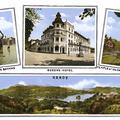Darjeeling (Himalaya)
The postcard artist, who signed other cards in this India series published by an obscure Munich firm, was Johann Friedrich Perlberg (1848-1921). Son of a painter, he best known for his paintings of Egypt, Palestine and the Middle East, many of which









